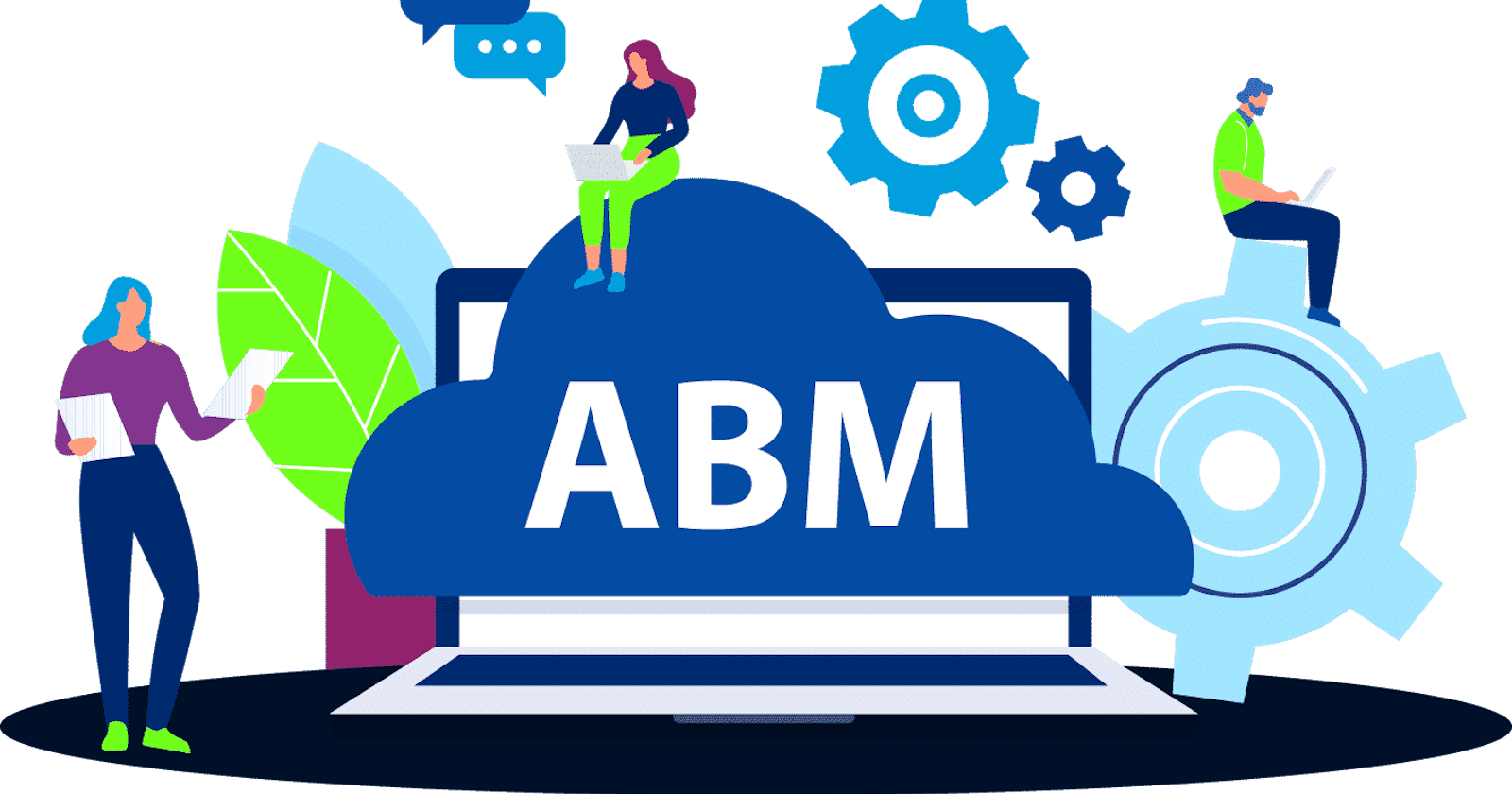Account-based marketing is a B2B approach that focuses on best fit accounts within a target market. Instead of mass marketing, ABM involves identifying prospects (both as accounts and as buying units) based on how well they mirror the attributes of the ideal customer. These identified prospects are then subjected to sales pitches over a short or extended timeline.
Account-based marketing also has definite characteristics that distinguish it from conventional marketing frameworks. That's what we'll unpack in this review as we explore ABM under these headings
- A little red Ferrari, problems with conventional demand gen
- ABM foundations
- Features and characteristics of ABM
- Common mistakes and problems in ABM
A little red Ferrari, problems with conventional demand gen
Let's start with a short story. Steve watt was employed as the director of demand gen at a 10-year-old company. His problem was that he now led a really strong team that was excelling at both inbound and outbound marketing.
In striving to make a mark at the organization, he searched for a gap in their entire sales process. What he discovered was that despite their strong sales record, they still had failed to close deals on a large number of accounts.
On observing this, his solution was to:
1) First identify one hundred of these accounts that should have already been customers.
2) Then he got to know the buying decision-makers behind those accounts
Characteristics of the decision makers The people making the decision about the products he sold were analysts and associates in investment banks. These guys were very high achievers, they came out of great schools, they were incredibly driven, they were already making a lot of money, especially for their ages.
They were also working really long hours, 90 and 100 hour work weeks are not uncommon in those roles, and that's how you get ahead in investment banking.
You work extremely hard, you give up everything to work so hard and make your way up, and when you do make your way up, It's not die-cast Ferraris, It's real Ferraris and Lamborghinis that become your reward. As for these young guys, this was the reward they all wanted
No alt text provided for this image So Steve Watts and his team used little red Ferrari's as a way of breaking through with these guys.
How do you get the attention of someone who works 100 hours a week?
Well, you better make a mark, you better make an impact,and it better be relevant.
So they sent these Ferraris to them.
First of all, the reason for the Ferrari,
and the messaging around it, was the idea of "we'll help you get there faster"
And it worked on multiple levels.
Obviously, a Ferrari is a very fast car.
But also, by being the champion who brought the software into the bank, the subliminal message was that they could accelerate their careers faster
Steve's third layer of meaning was that his company's software worked faster than the legacy competitors. So Steve and team had a story around speed represented in this beautiful Ferrari.
Steve and team also told them, look, there's a $50 Amazon gift card with your name on it, if you'll take a 20-minute demo with us. They put that information in an actual gift box, in the packaging, mailed it to these prospects and followed up with emails and in-mails to reiterate the offer.
The goal was to not just get wins but to learn lessons needed to scale and iterate on this approach (hence an A/B test was conducted with segments of these prospects).
Long story short, it was a resounding success.
Here are the results
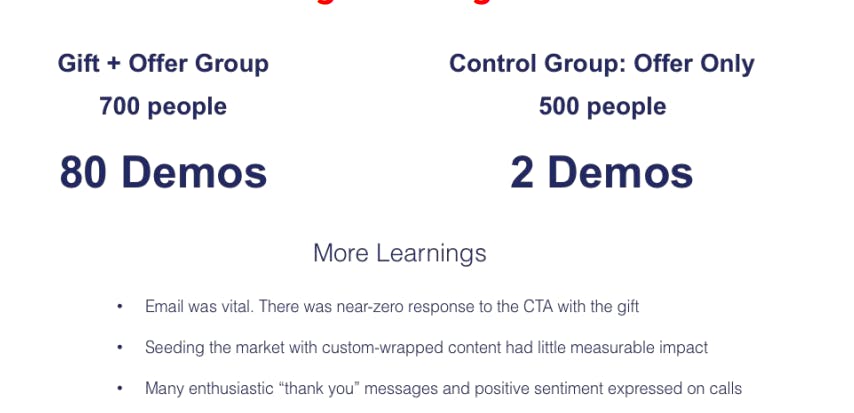
Learnings
As great as this was, there was still more to learn. One thing they learned was that email was vital.
Although there was a call to action right in the packaging with that Ferrari (along with a custom URL they could use to book their demo and claim their gift card) hardly anyone responded to the CTA.
It took the Ferrari to grab their attention,
it took the emails and the in-mails to make them follow through.
Steve also learned that pre-seeding the market with some custom branded content helped get some air cover in advance, but after testing, they realized that it didn't matter, and It didn't work.
It was all about the power of the Ferrari, the follow-up, the incentive and that's what cut through.
So let’s keep Steve's examples in mind as we lay out the foundations of ABM
ABM: Laying the Foundations
Once upon a time, B2B marketing was easy. It was a basic funnel of awareness, consideration, decision & purchase. All you had to do was put leads at the top, nurture & qualify them, and out came a paying customer.
The more leads you put in, the better you nurtured and qualified them, the more money that came out of the bottom. While this was great, something better came along in the last few decades. SEO and SEM guys with the capacity to put far more leads at the top, thus offering the promise of even more revenue.
The marketing automation guys also came along saying: "the nurturing and qualifying process is inefficient, we can personalize and automate it", thus promising even more revenue (out of the same number of leads) for less manpower.
A little while later, the content guys came along with the maxim "content is king". They said: "You need better content to get the leads to self segment according to their interest in your offering, and you also need content to nurture and move them down the funnel"
All these voices were right, and these developments made B2B more effective than it had ever been before. Nevertheless, according to Forrester the closing rate in B2B marketing is still less than 1%, while the number of people involved in the buying process averages at around 6.8 (~ 7 people make B2B buying decisions).
Now these stats, particularly the latter, debunk the myth that an individual can be converted into a customer in the B2B context. In fact, the larger the organization, the larger the deal, the more complex the deal, the more people you'll find in the buying unit. So this brings us to the main B2B problem that created the need for ABM, and that is:
When you have a lot of people in the buying unit, and a small lead to close rate, you need an entirely new approach to marketing.
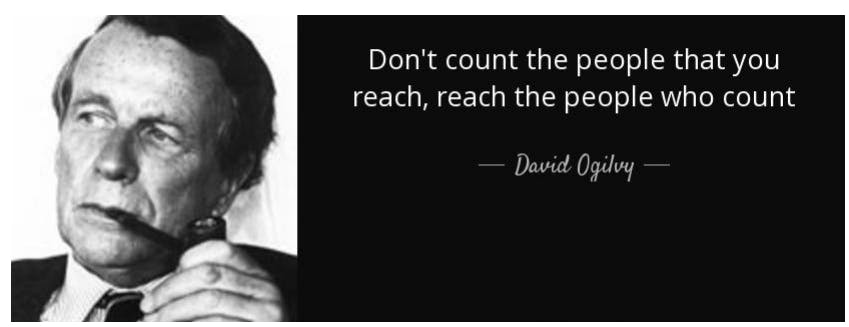
And he's right. That's why ABM emerged because it is all about identifying the right people in the right accounts and moving them forward to becoming your customer. I.e
ABM is a sustained, coordinated, strategic approach to identifying, engaging, closing, and growing the accounts that we know we should win.
Here are other ways that ABM can be described
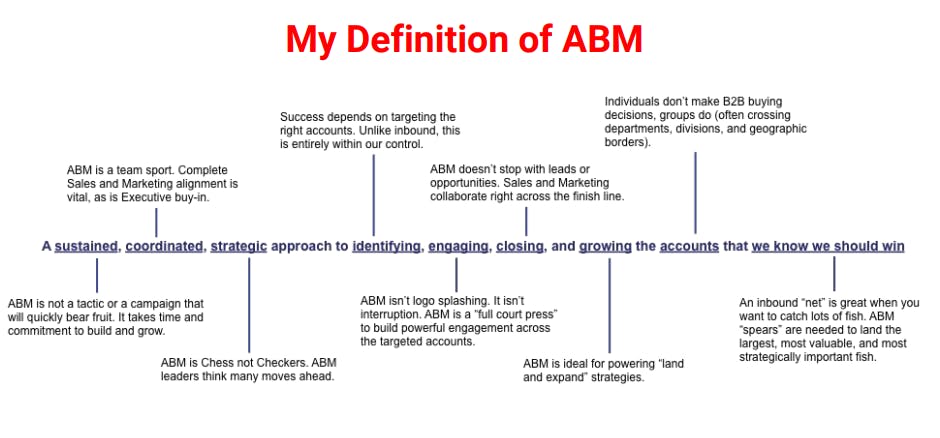
What ABM is not
- ABM is not a tactic, it's not a channel, and it's not a campaign
- ABM isn't logo splashing or interruption either
- ABM is not an inbound "net" for gathering customers
- It's not about individuals, it's about accounts
Features and characteristics of ABM

Read: The Modern Approach To Account-Based Marketing ABM differs from conventional B2B in many ways, but one of its characteristic features is that of the flipped funnel i.e. while B2B has a conical funnel, ABM has a pyramidal funnel in this order
Accounts *(starts with identifying the right accounts) < Decision-makers (identifying the right people within the accounts) < Account specific insights (what are we going to say to them) < Engagement channels (how are we going to reach them) < *Sales Pipeline (revenue)
Explore: 6 PPC Tactics for Account-Based Marketing Campaigns
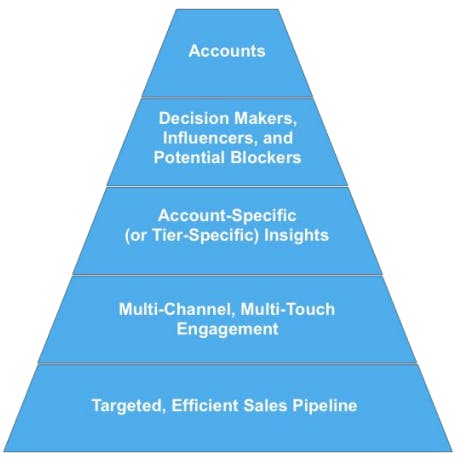
Not only does ABM differ from conventional B2B in terms of funnel hierarchy, it is also of three main types which are;
Strategic one to one ABM: This is how we handle very complex, very large deals, usually involving a very small universe of accounts. It requires the marketer to dive incredibly deep in order to clinch these giant deals.
Programmatic ABM: This is how to go after hundreds, maybe even a few thousand accounts in a less strategic, less customized, more tech-enabled way
ABM-Lite: This is a mixture of the two. It is researched, it is highly targeted. It's very focused, but on a cluster of accounts within a particular industry or users of a particular technology for those at a particular phase of their development
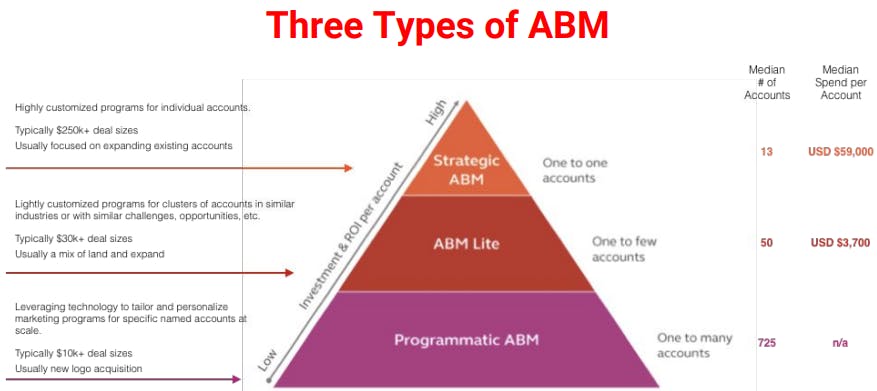
Other factors to consider when deciding on the type of ABM to implement are;
- Deal size
- Complexity of your product or solution
- Size or complexity of customer/prospect orgs
- Number of customer/prospect stakeholders
- Strategic importance of particular clients
- Current perception (if any) of your firm
- Competitive environment
- Internal factors (budget, talent, alignment etc)
**Common mistakes and problems in ABM
** These are some of the ABM problems that can derail an ABM process
1) Lack of Executive & Sales Alignment
People say that alignment is important, but oftentimes they stop there and they don't provide advice and guidance as to how to achieve this alignment. To achieve alignment, these are some things to note
- Salespeople and executives will not take action in alignment until they believe it is key to their success
- Salespeople and executives will not believe ABM is anything other than a marketing “flavor of a month” until they have highly-impactful experiences, unlike anything experienced before
- We can’t tell people what to do. We can’t compel them to believe in ABM. We need to create experiences that alter their beliefs and ultimately lead to the right actions
2) Measuring the Wrong Things We all know that marketing absolutely is metric-driven, it's data-driven. But we sometimes make the mistake of thinking that the metrics from what we're doing today are necessarily the right metrics for what we're going to do tomorrow. That's not always the case with ABM. There's a number of different ways of measuring ABM. So one approach is the idea of
- coverage,
- engagement, and
- impact
And especially if your deals are large and your sales cycles are long, you can't just say, we're going to wait and see the revenue in a year and that'll tell us whether we're doing the right things or not. You need some nearer afield metrics to tell you that you're doing the right thing to build the right foundations, build the right capabilities and that you're on the road to success.
So coverage & C.E.I can help with that. Here are the questions that the concept of coverage, engagement, and impact can help you answer in a bid to start measuring well

- Are you adequately identifying the right people in the right accounts, the right ways to get to them?
- Are you actually engaging them?
- Are they starting to interact with you in various measurable ways?And then you can start to see the impact over time.
So this can be a pretty effective framework.
Another measurement framework in ABM is
- Relationships,
- Reputation, and
- Revenue
For Relationships, here's what to consider
- I've heard of (company) and thoroughly know what they do
- I've had some sort of communication with [company]
- I know someone at [company]
For Reputation the things to consider are
- I respect the (company) person or people I know
- (company) is a leader, they do things better than their competitors
- I respect the company and they are a visible contender for my business.
For Revenue, here's what to consider
- We are a customer of the (company)
- (Company) is our primary provider and trusted partner
The third measurement approach is the use of market-qualified accounts as opposed to marketing qualified leads. While others use a wide variety of metrics such as
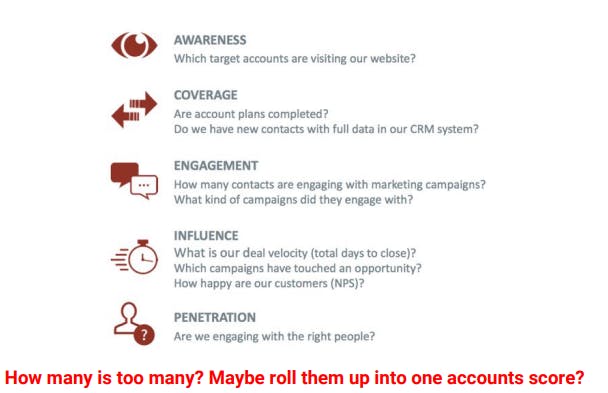
Skipping the Pilot
Do not skip the pilot. How do you go about planning a pilot? First, it needs to be large enough to be material and small enough to be safe.
if you run a pilot that's successful but doesn't move the needle then you haven't really accomplished anything. At the other extreme, if you build a pilot that's so big that if it fails your job is in jeopardy, then you've probably set out on the wrong path as well.
You need to find that place in between. But how do you size a pilot so that it's big enough to matter and small enough to be safe?
You need to focus.
Also remember that no matter what the results of your pilot are, if you have not learned really important things about what audiences, what channels, what tactics, what tools, what assets are highly effective, then you've missed a huge opportunity. And these learnings are the foundation for your scaling.
Don't skip the pilot. And really, really spend some time to make sure you get the pilot sized and planned correctly.
Conclusion
Remember that in ABM, people aren't coming to you. They're not reaching out to you. This is not inbound. You need to cut through the noise, you need to delight them and engage them and pull them into a conversation.

